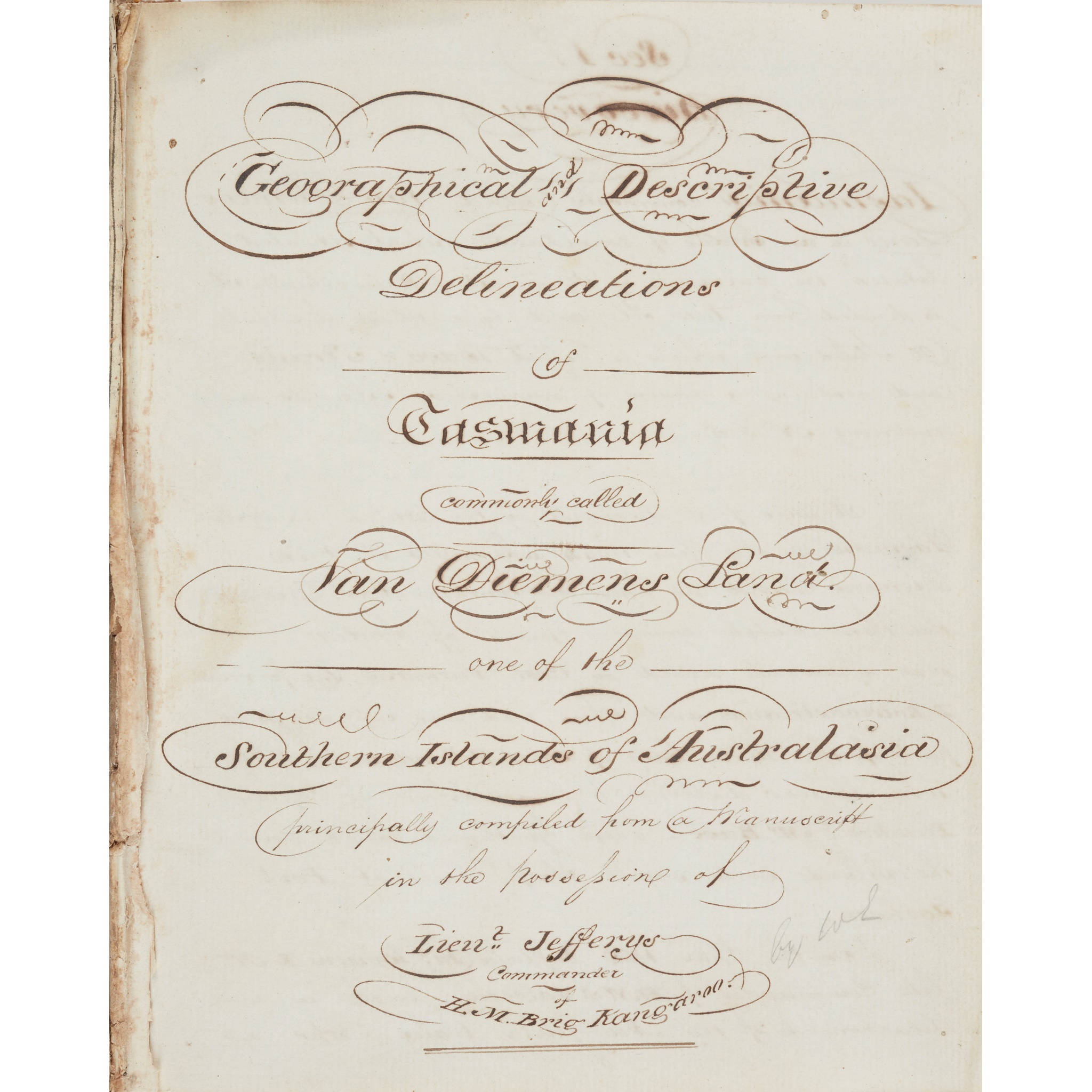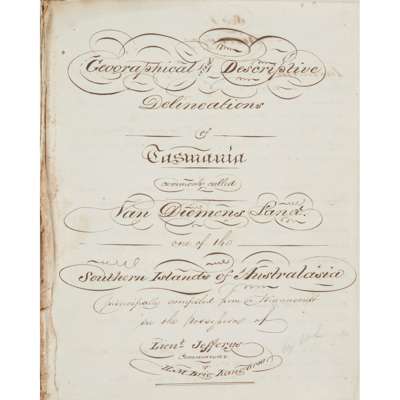
Lot 15

Australia Manuscript - Tasmania
Jeffryes, Lt. Charles


Rare Books, Manuscripts, Maps & Photographs
Auction: 8 February 2023 at 10:00 GMT
Description
'Geographical and Descriptive Delineations of Tasmania, commonly called Van Dieman's Land, one of the Southern Islands of Australia principally compiled from a Manuscript in the possession of Lieut. Jefferys, Commander of H.M. Brig Kangaroo'. Small 4to (195 x 150mm) Manuscript, 155 pages, in a neat copperplate hand. [paper watermarked 'G. Pike', '1815', '1817', '1814', 'C. Ansell' & '1818'], contemporary calf, spine gilt;
The work comprises:
pp.1-2 Discovery;
3-4 Climate and Face of the Country;
4-6 Mountains;
6-16 Rivers;
16-19 Lakes and Ponds;
19-24 Coasts, Bays, Ports, Harbours and Anchorages;
24-44 Interior of the Island;
44-66 Observations in 1820 with List of Grants in the County of Buckingham up to Christmas 1810 (initialled 'W.E.');
67- 109 Narrative of the Atrocities committed by Michael Howe, the Bush-Ranger and his Associates during a period of 6 Years in Van Dieman's Land (Compiled from authentic sources of information);
110- 122 Rio de Janeiro (dated September 1819 and initialled 'W.E.');
123-124 Copy Bond entered into on leaving Sydney in the Sloop 'Martha' for Port Dalrymple;
125 Copy Letter written by W.E. at the request of the Master of the 'Martha' on coming to an anchor in Botany Bay on Sunday February 13th 1820;
126-136 Copy Assignment of Leasehold premises in New South Wales prepared by W.E.;
137-141 Mortgage. This indenture made between T.C and M.A.L. ...;
142-155 Copy Protest. New South Wales. By this Public Instrument of Protest [relating to the ship 'Martha'] ending 'TH [or JH] Williams, Inner Temple, 31st Dec. 1819' and 'Subsequently decided in favor of [ ] in the Court of Common Pleas, W.E.'
Footnote
Note:
Charles Jeffreys's book with a slightly different title, Van Dieman's Land. Geographical and Descriptive Delineations of the Island of Van Dieman's Land, was published in 1820 in London by J.M. Richardson, as an octavo and comprised [vi], 168 pages.
'Charles Jeffreys (1782-1826), naval officer and author, was born on 16th October 1782 at Cowes, Isle of Wight, England, the son of Ninian and Mary Jeffreys. He joined the navy at 11 and served as midshipman in various ships before his passing certificate as lieutenant was issued by the Admiralty in August 1803. He was commissioned lieutenant in March 1805. In August 1810 at Lambeth, Surrey, he married Jane Gill of London. In January 1814 he arrived with her at Port Jackson in the brig Kangaroo.
Jeffreys's first commission was to transport convicts and other passengers in the Kangaroo from Port Jackson to the Derwent. After an unsuccessful attempt in May 1814 he finally sailed for the Derwent in August and arrived at Hobart Town in October. Instructed to return to Port Jackson by way of Port Dalrymple to collect a cargo of wheat Jeffreys travelled overland, but though the Kangaroo sailed for Port Dalrymple later in October it did not re-enter Port Jackson until February 1815. Governor Lachlan Macquarie was dissatisfied with Jeffreys's explanation of the delay, wanted to send the brig back to England as unfit for service and to discharge Jeffreys, whom he thought a timid seaman and ignorant of his duties; however, in April he dispatched Jeffreys to Ceylon with the remainder of the 73rd Regiment. Whilst on this voyage Jeffreys named Molle Island in the Whitsunday Passage after Lieutenant-Governor George Molle, and Mount Jeffreys on Molle Island after himself. When sailing around Cape York Peninsula in May he discovered and named Princess Charlotte Bay. After his return to Port Jackson in 1816 he made two trips with convicts and stores to the Derwent, which he carried out satisfactorily, but in April 1817 the governor, still critical of Jeffreys's incompetence, reported that he was sending him in the Kangaroo to England. Macquarie instructed him not to touch at any port in either of the colonies, but Jeffreys disobeyed his instructions. He entered Hobart at the end of April under the pretext that he had lost a boat and suffered some damage, but with the real purpose of landing a large quantity of spirits. While the brig was in the Derwent it was learned that several prisoners were missing from Hobart, that two prisoners had been stowed at Port Jackson, and that the escaped Sydney merchant, Garnham Blaxcell, who owed a large sum of money to the government, was on board. When Lieutenant-Governor William Sorell ordered two boats to patrol the river on the evening of 6th May Jeffreys boarded one of them, beat and abused the commander, Captain Jones, and took him and other crew members on board the Kangaroo as prisoners. The captured men were released next day and Jeffreys sailed for England a week later. Macquarie hoped that Jeffreys would be suitably punished, but legal impediments prevented his trial in England; however, at least he had given the British government the means of successfully prosecuting its claims against Blaxcell.
While in London Jeffreys arranged for publication of his Geographical and Descriptive Delineations of the Island of Van Diemen's Land in 1820. Most of the information for his work was obtained from the manuscript of Surveyor George William Evans who had travelled in the Kangaroo between Van Diemen's Land and Port Jackson. The book, now rare, was the first of many guides for immigrants intending to settle in Van Diemen's Land.' [Australian Dictionary of Biography, volume 2, 1967].
Evans accused Jeffreys of plagiarism in his introduction to the second edition of Evans' own work, A Geographical, Historical and Topographical Description of Van Dieman's Land, with Important Hints to Emigrants, which was first published in 1822. It would appear that the present manuscript is a copy of the copy made by Jeffreys of Evan's manuscript purloined by Jeffreys whilst Evans was on board the Kangaroo. It is conceivable that it could be the actual copy made by Jeffreys (or at his order), with the title suitably worded to make it sound as though it was Jeffreys' own work, or at least with no reference to Evans as being the author. For a biography of George William Evans (1780-1852), see Australian Dictionary of Biography, George William Evans.
See also the manuscript lot in this sale by W.C. Wentworth.
In May 1820, Jeffreys and his wife returned to Hobart in the Saracen, and later obtained a grant at Pittwater of 800 acres (324 ha), which he named Frogmore. The first house and all its contents were destroyed by fire soon after being built, but he immediately laid the foundations of another. However, Jeffreys did not prosper as a farmer. He died on 6th May 1826 and was buried at Sorell. His widow remained in the colony, and was allowed an additional grant of 500 acres (202 ha).
Provenance: William Macpherson, the son of Colonel Allan Macpherson who bought the Blairgowrie Estate which included Newton Castle. He was born in India in 1784 and came to Scotland at the age of three with his parents. He emigrated to Australia in 1829, having spent a decade growing cotton in Berbice in the West Indies. He was Collector of Internal Revenue in New South Wales, and later served (for 24 years) as Clerk of the Councils in New South Wales. He left agents and members of the family in charge of Blairgowrie Estate. He died in 1866 having lived in New South Wales for more than thirty-six years. By descent to the vendor.

